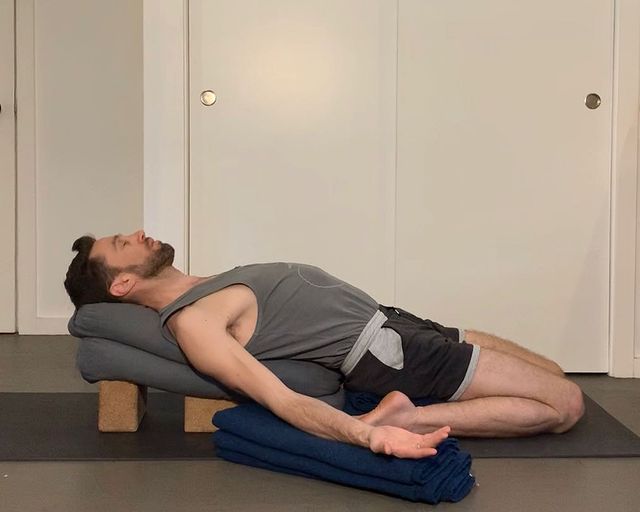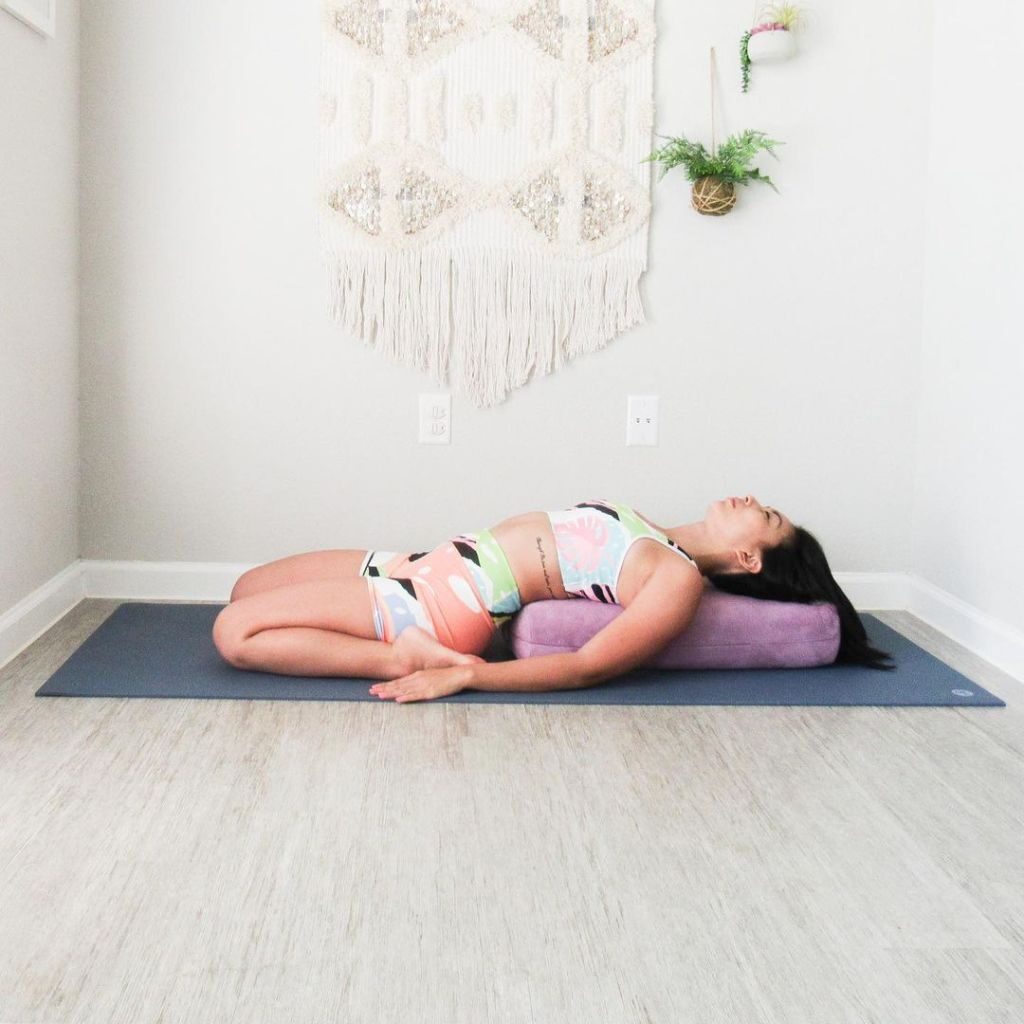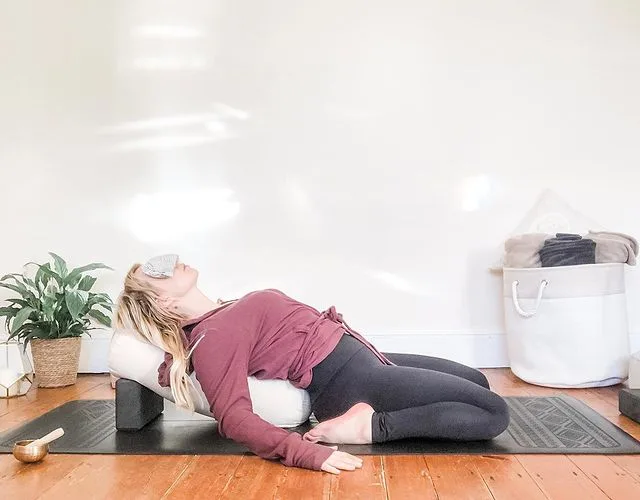Supta Salamba Virasana, also known as Reclining Hero Pose or Supported Hero Pose, is a restorative pose that has the ability to rejuvenate the body, relieve fatigue, and it promotes health and function of the hip, knee and ankle joints.
When you are unable to breathe well, you may feel a sense of anxiety, even panic.
Supta Salamba Virasana (Reclining Hero Pose or Supported Hero Pose) can reduce these feelings by relaxing you and opening the lungs, which is called tidal volume. This is the amount you normally breathe in and release when you are resting. When tidal volume decreases due to rib cage, asthma, bronchitis, or other causes, there is a build-up of carbon dioxide, or respiratory waste, in the bloodstream. Carbon dioxide acts as an irritant to the nervous system, thus creating anxiety.
Try Supta Salamba Virasana if you are congested in the upper respiratory region and want to improve your ability to breathe normally while at rest.
Information
| Known as: | Reclining Hero Pose, Supported Hero Pose, Supta Salamba Virasana, Reclined Hero Pose With Blankets, Supta Virasana With Blankets, Reclined Supported Hero Pose Variation Bolster, Supta Salamba Virasana Variation Bolster |
| Sanskrit name: | सुप्त सालम्ब वीरासन |
| IAST: | Supta Salamba Vīrāsana |
| Pronunciation: | Soup-tah sah-LOM-bah veer-AHS-anna |
| Level: | Beginner |
| Type: | Relaxing, Restorative, Back-bend Posture |
| Total time: | 3 to 4 minutes |
| Drishti: | Eyes closed; Upward |
| Chakra: | Sahasrara Chakra, Ajna Chakra, Vishuddha Chakra |
| Focus: | Legs, Spine |
| Indications: | Varicose veins, menopausal discomfort, respiration, high blood pressure, sciatica, infertility, insomnia, flat feet, thyroid and parathyroid productivity |
| Counterposes: | Adho Mukha Svanasana (Downward-Facing Dog Pose) |
| Preparatory poses: | Butterfly Pose, Child’s Resting Pose, Cobra Pose, Urdhva Mukha Svanasana, Cow Face Pose, Hero Pose |
| Follow-up poses: | Padmasana, Balasana, Baddha Konasana, Bakasana |
| Contraindications: | Heart disease, Knee or ankle injury, Arthritis, Pregnancy (first trimester; use additional props) |
Meaning + Origin
The Supta Salamba Virasana is derived from the Sanskrit name, which is made up of four words — Supta + Salamba + Vira + Asana:
- “Supta” = “reclining”
- “Salamba” = “supported or with support”
- “Vira” = “hero”
- “Asana” = “pose or posture”
Benefits of Supta Salamba Virasana (Reclining Hero Pose)
The pose opens up the upper respiratory tree—throat, bronchial tubes, and upper lungs. It relieves pressure in your head from sinus problems. In general, this yoga posture reduces fatigue in your legs due to walking and standing. It also provides relief from indigestion and nausea by lifting the diaphragm from the stomach and liver.
However, the physical and mental benefits of Supta Salamba Virasana (Supported Hero Pose) are listed below:
- Physical Benefits:
- Promotes the health and function of the hip, knee, and ankle joints
- Opens and releases the lower back
- Opens the chest for greater lung capacity
- Therapeutic for high blood pressure
- Calms the nervous system
- Stimulates thyroid and parathyroid productivity
- Helps relieve menopausal discomfort
- Mental Benefits:
- Reduces stress
- Relieves mild depression
- Relieves anxiety
- Calms the mind
- Creates a feeling of grounding and stability
Reclining Hero Pose (Supta Salamba Virasana) Practice Guide
Equipment needed
- Props:
- Optional Props:
- Eyebag
- Towel
- 1 to 2 single-fold blankets
- Block, book, or blanket
- Extra blanket for warmth
- Clock or timer
1. Steps to Supta Salamba Virasana

Pose preparation
Before attempting Supta Salamba Virasana (Reclining Hero Pose), determine how comfortable you are in Hero Pose, the seated variation. Stand with your feet hip-width apart and feet pointing straight back. It is important that your feet are in proper alignment. Sitting in Hero Pose with your legs bent causes the lower leg bones to bend and the inner knees to stretch.
Instructions
Step-1
- Sit down slowly, keeping your buttocks firmly between your legs on the floor. When you sit comfortably, and you don’t feel any discomfort in the knees, ankles, or feet, then you can move on. If not, try adjustments; Sit on a block, a book, or a blanket folded into a small bundle. If you feel any discomfort in your knees, then get into a kneeling position.
- Reach down and gently pull the calf muscles in toward your heels, holding them back as you squat down. This simple motion creates extra room for the knees to bend and takes some stress off these joints.
- If you feel discomfort in your ankles or feet, place a rolled-up towel under your ankles.
Step-2
- Once you’ve determined your prop needs, place a single-fold blanket over one end of your bolster, and sit in Hero Pose in front of the other end. Using your hands for support, slowly lie back and rest your torso on the bolster and your head and neck on the single-fold blanket.
- You can increase the height of the support by adding 1 or more single-fold blankets over the bolts.
- Make sure your stomach is comfortable, and your chest is open. The bottom of your breastbone should rise up, not sink. When in position, you should be resting with your torso at a 45-degree angle to the floor. You are not lying flat on your back, but taking a half rest between lying down and sitting.
Step-3
Supported Hero Pose is traditionally practiced with the knees bent or almost together. It recommends that you perform exercises with your knees together or as far apart as necessary to make your lower back, knees and feet comfortable. It can be as small as 6 inches or as much as 14. Take the time to find the right distance for you.
Step-4
- Cover your eyes with eyebags. Place each forearm on a folded blanket.
- Lying down with your hips, feet, and knees in this position may seem unusual at first, so give yourself time to sit down. Allow the top of your thighs to drop toward the floor.
- When the legs feel heavy, the chest will feel lighter and expand more with each breath. With each inhale, allow the top of your chest to lift and expand horizontally.
- As you exhale, imagine that the chest does not go back to its position before inhaling, but remains lifted and expanded. Each cycle of breathing opens the chest cavity more and more.
- If at any point your breath becomes short, release all effort to expand the chest, and allow your body to re-establish the rhythm of your breathing.
- Then start expanding the upper chest while breathing slowly. Each breath can stretch the lung tissue, opening the breathing passages, and making way for more incoming breaths.
- Remember, breathing is like a visitor, warmly welcomed upon arrival and gently released upon departure.
Step-5
- Practice Supta Salamba Virasana for 3 to 4 minutes. As you get used to it, you can practice for up to 10 minutes.
- There are two ways to come out of this asana:
- Use your arms to lift your torso up and forward, and get on your hands and knees. Slowly straighten your legs and walk your hands back towards your feet. Bend the knees slightly and slowly stand up.
- Use your arms to lift your torso up and forward, and get on your hands and knees. Keep one foot forward from this position. Standing with most of your weight on that leg, bring the other leg forward.
2. Steps to Supported Hero Pose (Supta Salamba Virasana)

Instructions
- Bend your knees and sit on the floor with your heels on the outer edge of your hips. Place a large, flat bolster on the side of your hips behind your body. Align your thighs parallel and straight to your hip socket. Press the tops of your toes into the floor to connect your ankles, feet and calves.
- Bend your elbows and lean on the bolster, keeping your spine long.
- Rest with your arms on the bolster with palms are face down or upward and receptive. Allow the shoulders to melt back around the bolster. Keep your hips on the floor. Scoop your tailbone up and down and extend from your hips to your knees. Relax the shoulders and open the chest.
- Once supported, relax and come into the pose, focusing on your breath.
Precautions and contraindications
- Do not practice Reclining Hero Pose if you feel a sharp strain or pain in or around the knee. If you experience a generalized strain or minor pain that resolves immediately upon coming out or adjusting your props, it’s probably okay to move on. If difficulty persists, consult your doctor or health care professional.
- This pose can cause discomfort in the tops of your feet, especially if you have high arches or tight calf muscles. Try practicing Reclining Hero Pose on your bed.















